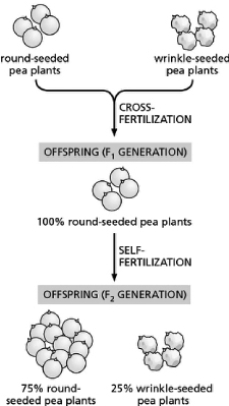Multiple Choice
Figure 19-24 diagrams one of Mendel's experiments using the round and wrinkled seed traits.  Figure 19-24
Figure 19-24
Which of the following statements about the experiment diagrammed in Figure 19-28 is TRUE?
A) If you crossed all the round-seeded pea plants from the F2 generation with true-breeding wrinkle-seeded pea plants, you would get more round-seeded pea plants in the next generation than if you crossed all the round-seeded pea plants from the F1 generation with true-breeding wrinkle-seeded pea plants.
B) The reason you do not see wrinkle-seeded pea plants in the F1 generation is because the round-seeded pea plants used to create the F1 generation were not true-breeding strains.
C) The gene for round-seeded pea plants is on a different chromosome from the gene for wrinkle-seeded pea plants, which is why you get 25% wrinkle-seeded pea plants in the F2 generation.
D) If you crossed the round-seeded pea plants from the F2 generation with the wrinkle-seeded pea plants from the F2 generation, you should get 100% round-seeded pea plants.
Correct Answer:

Verified
Correct Answer:
Verified
Q21: Figure 19-27 is a diagram of chromosomes
Q22: During fertilization in humans,<br>A)a wave of Ca<sup>2</sup><sup>+</sup>
Q23: Meiosis includes a recombination checkpoint that is
Q24: You conduct a genetic screen on
Q25: Figure 19-24 diagrams one of Mendel's experiments
Q27: Gene A is located near gene B
Q28: Finding co-inheritance of an SNP variant and
Q29: Which of the following statements about genome-wide
Q30: The formation of a bivalent during meiosis
Q31: Which of the following statements is FALSE?<br>A)Asexual